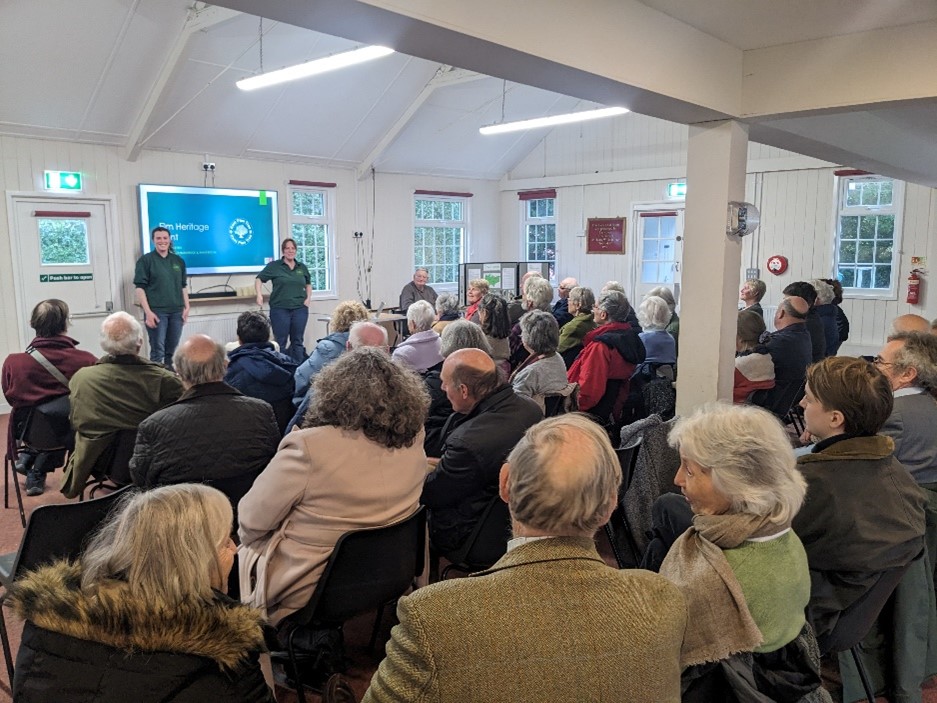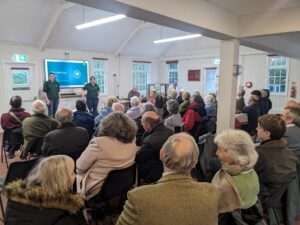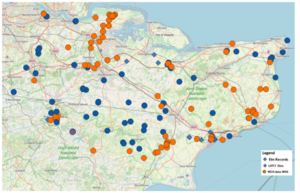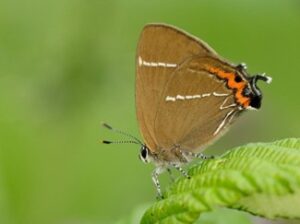
On 21 January an audience of 40 was delighted to welcome Lyndsay and Anna, two representatives from Kent Plan Tree, to brief us on the Elm Reintroduction project; our first Winter Season presentation.

A good turnout at the Lads’ Club in Saltwood, demonstrating an enthusiastic response to the reintroduction of elm to the Kent landscape.
Elm trees have long been part of the British landscape, and they were particularly abundant in Kent. As we all appreciate, Dutch Elm Disease (DED) caused the loss of these trees in the second half of last century…although pockets of elm trees continue to survive.
Survival of the White-Letter hairstreak butterfly is critically dependent on the presence of elm trees, as the grubs hatching from eggs laid on the leaves eat the emerging buds of the trees. Joining up the pockets of elm trees will allow migration and expansion of the area where this butterfly can survive.
The project has been working to map the sites of existing elm trees and cross-referring to sightings of the White-letter hairstreak butterfly; this is a tricky task using only patchy and older data, so they have encouraged other parties to collect and share data to update and enhance the map. Members of our charity have been involved in sharing data for this project.
The map (Fig 1) shows gaps where no trees of butterfly sightings are reported, as well as clusters / hotspots of existing elm trees in what appears as a coastal ring around Kent. The Royal Military Canal was apparently planted with thousands of Elm trees to stabilise the embankment on the landward side of the canal and, although a huge number were lost to the disease, there are still many elm trees of different sizes along the canal.

Fig 1: Map of Elm sites and White-letter Hairstreak butterfly sightings – copyright Kent County Council Kent Plan Tree
The project will continue to encourage reports from volunteers of surviving Elm trees and sightings of the White-letter hairstreak butterfly. The butterfly forages happily on bramble flowers but prefers to live in the high canopy where the eggs are also laid…it is not the easiest of butterflies to spot!

The butterfly has approx. 3.5cm wingspan
Adults fly in July and August and the caterpillars are active in April and May
If you have information on existing elms or the White-letter hairstreak butterfly, please use the following data links, or make contact with Kent Men of the Trees.
- Upload Elm records to (International Records) iNaturalist
- Upload Elm records to (UK Records) iRecord
- Upload White-Letter Hairstreak to iRecord Butterflies.
The presentation was very well received by the group and provoked many questions, as well renewed personal enthusiasm to source disease-resistant trees for planting.
With the kind consent of Kent Plan Tree Partnership, we are also able to share a pdf version of the presentation and below are all the relevant links, including some additional as a result of the questions.
We can also offer another oppportunity to view the presentation, a recording is available at a small charge, please contact Denise admin@kentmemenofthetrees.co.uk for details.
Elm Heritage Kent Presentation
Recording data
- KMBRC – Home | Kent & Medway Biological Record Centre
- INaturalist app – Observations · iNaturalist United Kingdom
- IRecord app – Explore | iRecord
- IRecord Butterflies app – iRecord Butterflies | Butterfly Conservation
Identification links for British Elm and White-letter Hairstreak
Elm info and where to buy
- P19 for suppliers – DISEASE-RESISTANT ELM CULTIVARS

